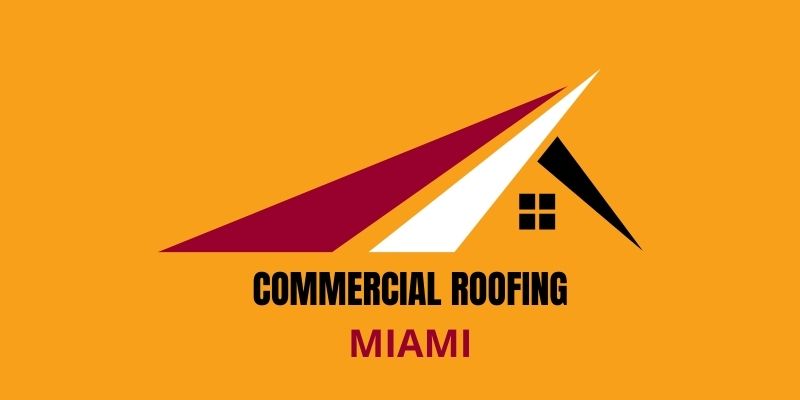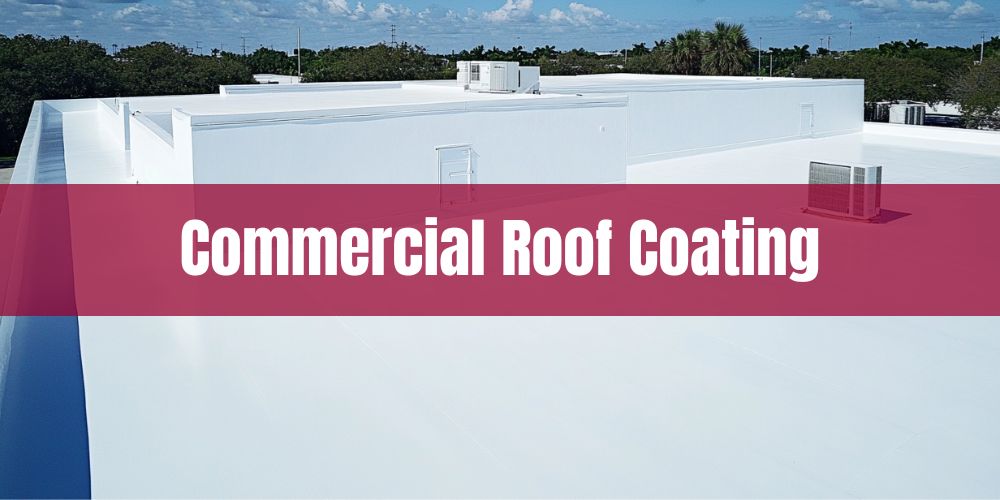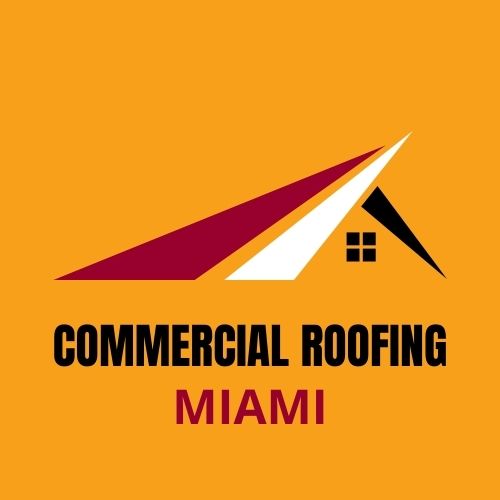Commercial roof coating is a protective layer applied to commercial roofing systems, aimed at extending the roof's lifespan and enhancing its performance. These coatings, often made from silicone, acrylic, or polyurethane, help to seal, protect, and waterproof the roof surface. By reflecting UV rays and reducing heat absorption, commercial roof coatings also contribute to energy efficiency and can lower interior cooling costs. Typically used on flat or low-sloped roofs, these coatings improve resistance to weathering, ponding water, and other environmental stressors. Commercial Roofing Miami provide commercial roof coating services across the Miami, Florida area.
What Is Commercial Roof Coating?
Commercial roof coating is a protective layer applied to commercial roofing systems designed to extend the life of the roof by offering durable and robust protection. These coatings are typically formulated from materials such as acrylic, silicone, polyurethane, or asphalt, each bringing unique benefits depending on the roofing needs. A primary function of commercial roof coatings is to provide waterproofing, protecting the roof from leaks and water damage. Additionally, these coatings offer UV protection, which not only shields the roof material from sun-induced degradation but also aids in reducing energy costs by reflecting sunlight and heat away. Application methods vary and can include spraying, rolling, or brushing directly onto the existing roof surface. The ultimate choice of coating material and method depends heavily on the specific weather challenges and structural conditions of the building's location.
In Miami, Florida, commercial roof coatings must prioritize high solar reflectivity to mitigate the intense sunlight and heat. Given Miami's propensity for heavy rainfall and high humidity, selecting coatings that excel in waterproofing and resisting mold and mildew is essential for optimal roof performance and longevity.
Have a question about an upcoming project?
What Are The Benefits Of Commercial Roof Coating In Miami?
Commercial roof coating in Miami offers enhanced durability, energy efficiency, and protection against extreme weather conditions. Miami's climate with its intense heat and frequent storms makes roof coatings an essential option for maintaining commercial properties. These coatings help to extend the lifespan of the roof while reducing energy costs and preventing water damage.
- Weather Resistance: Provides protection against Miami's intense UV rays and heavy rainfall.
- Energy Efficiency: Coatings reflect sunlight, significantly lowering cooling costs in hot climates.
- Leak Prevention: Creates a seamless, waterproof barrier, reducing the risk of leaks and water damage.
- Extended Roof Life: Enhances durability, delaying the need for costly roof replacements.
- Sustainability: Reduces environmental impact by minimizing heating and cooling energy consumption.
1. Weather Resistance: Provides protection against Miami's intense UV rays and heavy rainfall.
Weather resistance in commercial roofing refers to the capability of a roofing system to withstand and protect against environmental elements such as prolonged exposure to intense UV rays and heavy rainfalls, reducing the risk of damage and maintaining durability. Miami's climate, characterized by intense sunlight and frequent rainstorms, demands commercial roofing systems that can provide reliable protection against these elements. The resilience against UV exposure ensures the roof’s material does not degrade prematurely, while effective water resistance prevents leaks and structural damage. Ensuring weather-resistant properties in your roofing can greatly extend its lifespan and performance, a critical factor in evaluating the benefits of commercial roof coatings in Miami.
To enhance weather resistance, commercial roofs in Miami can benefit from durable coatings that offer both UV protection and waterproofing capabilities. These coatings reflect harmful rays and channel rainwater effectively to prevent issues such as ponding or leaks. Regular maintenance, including inspections and timely repairs, ensures that the roof continues to meet the environmental challenges presented by Miami’s climate, preserving its structural integrity and cost-efficiency over time.
2. Energy Efficiency: Coatings reflect sunlight, significantly lowering cooling costs in hot climates
Energy efficiency refers to the ability of commercial roofing coatings to reduce energy consumption by reflecting sunlight and lowering cooling costs in hot environments. This energy-efficient feature provides a significant benefit for commercial buildings in Miami, where high temperatures can lead to substantial air conditioning expenses. By applying reflective coatings, these buildings can achieve lower cooling demands, enhancing their overall energy savings and reducing operational costs.
The use of reflective coatings in commercial roof systems also contributes to environmental sustainability by decreasing the heat absorbed by urban structures, which helps mitigate the urban heat island effect. Such coatings not only improve indoor comfort but also extend the lifespan of the roofing material by reducing thermal stress. Implementing regular maintenance and inspections ensures that the coatings continue to perform effectively, providing long-lasting benefits in energy efficiency and cost savings for commercial operators.
3. Leak Prevention: Creates a seamless, waterproof barrier, reducing the risk of leaks and water damage.
Leak prevention involves the integration of waterproof materials and techniques to establish an impervious barrier, significantly minimizing the likelihood of water intrusion and subsequent damage. For commercial roofing in Miami, the benefits of effective leak prevention are substantial given the region's high humidity and frequent rainfall. A seamless, waterproof barrier is essential to protect the building's structural integrity from the persistent threat of leaks, which are a common issue in such a wet climate.
Ensuring robust leak prevention measures on commercial roofs can significantly extend the lifespan of the roof by constantly deflecting water away from vulnerable areas. Regular inspections and maintenance to check for vulnerabilities will further ensure that any potential weak points in the waterproofing are addressed quickly. Employing advanced roofing systems that focus on seamless barriers is critical for maintaining a leak-free commercial property in Miami’s challenging weather conditions.
4. Extended Roof Life: Enhances durability, delaying the need for costly roof replacements
Extended roof life is achieved by using materials and coatings that increase the roof's resistance to wear and environmental damage, reducing the frequency of replacements and associated costs. In commercial roofing, especially in regions like Miami, extended roof life is a valuable benefit as roofs are subjected to intense weather conditions such as heavy rainfall and high UV exposure. By enhancing durability, businesses can avoid frequent, costly roof replacements, leading to better long-term investment and reduced operational disruptions.
Implementing high-quality roof coatings can significantly contribute to increasing a roof's lifespan. These coatings can reflect harmful UV rays and provide an added layer of protection against harsh weather elements, helping maintain the structural integrity of roofing systems. Regular maintenance and timely repairs further ensure the longevity of commercial roofs, ultimately safeguarding investments and maintaining business continuity.
5. Sustainability: Reduces environmental impact by minimizing heating and cooling energy consumption
Minimizing heating and cooling energy consumption refers to the use of roofing technologies and materials that aid in decreasing the amount of energy needed for temperature regulation within a building, thereby reducing its environmental footprint. This energy efficiency is particularly beneficial for commercial roofs in Miami, where high temperatures and humidity can lead to increased energy demands for air conditioning. By minimizing the need for extensive climate control, energy-efficient roofing solutions not only reduce operational costs but also decrease the building's overall carbon emissions.
Commercial roofing systems that incorporate cool roofing materials or reflective coatings can help deflect sunlight and thermal energy away from the building. This results in a cooler interior, reducing the reliance on artificial cooling systems during Miami’s hot months. Additionally, these sustainable roofing options contribute to the global effort to combat climate change by lessening the building's environmental impact through lower energy consumption and emissions.
Which Roof Coatings Best Suit Miami's Climate Conditions?
Reflective and UV-resistant roof coatings are ideal for Miami's hot, sunny climate. In Miami, where intense sunlight and humid conditions prevail most of the year, using roof coatings that effectively reflect UV rays and resist moisture can crucially enhance energy efficiency and longevity. Moreover, selecting coatings that withstand hurricane-force winds is essential for long-term durability.
- Reflectivity: High UV reflection reduces cooling costs and minimizes heat absorption.
- Moisture Resistance: Protects against Miami's frequent rain and high humidity conditions.
- Hurricane Durability: Ensures resilience against strong winds and storms typical in Miami.
- Energy Efficiency: Enhances thermal control, reducing dependency on air conditioning systems.
- Mold and Mildew Resistance: Prevents growth in humid environments to maintain roof integrity.
1. Reflectivity: High UV reflection reduces cooling costs and minimizes heat absorption.
Reflectivity in commercial roofing refers to the ability of roofing materials to reflect more UV radiation, reducing heat gain and lowering interior cooling demands. Reflective roofing materials are especially beneficial for commercial buildings in Miami where high temperatures and abundant sunshine prevail. By minimizing heat absorption, these materials significantly reduce energy costs associated with air conditioning, making them an optimal choice for optimizing energy efficiency in these conditions.
High reflectivity not only benefits energy consumption but also extends the lifespan of the roof by mitigating temperature-related damage. Applying cool roof coatings, which enhance reflectivity, can further improve performance and comfort, making it a viable investment for building longevity. Integrating reflective materials can contribute to sustainable urban development, combating the urban heat island effect prevalent in densely populated cities like Miami.
2. Moisture Resistance: Protects against Miami's frequent rain and high humidity conditions.
Moisture resistance is the capability of a roofing system to withstand water intrusion and moisture vapor transmission, essential for withstanding Miami's heavy rainfall and humid environment. Miami's climate conditions, characterized by frequent rain and high humidity, necessitate a roofing solution that excels in moisture resistance. Roof coatings that offer superior moisture resistance ensure that commercial buildings remain structurally sound by preventing water infiltration and minimizing the risk of leak-related damage.
Investing in a moisture-resistant roofing system is crucial for Miami’s commercial properties, where excess moisture can lead to mold growth and structural deterioration. Regularly applying specialized coatings can enhance the waterproofing capabilities of existing roofs, thus protecting assets and prolonging the structure's lifespan. Long-term roof performance relies on maintaining these protective barriers and performing timely inspections and maintenance.
3. Hurricane Durability: Ensures resilience against strong winds and storms typical in Miami.
Hurricane durability refers to the strength and structural integrity of roofing systems that are designed to withstand the extreme wind forces and storm conditions prevalent in Miami. Commercial buildings in Miami demand roofing solutions that can endure hurricane-level winds and intense storms due to the region's climate. The importance of selecting appropriate roof coatings that enhance this resilience is crucial for long-term protection against frequent and potentially devastating weather events.
To ensure hurricane resilience in commercial roofing, materials such as modified bitumen or reinforced single-ply membranes are commonly paired with advanced mechanical fastening systems to enhance wind uplift resistance. Regular inspection and maintenance of roof structure help sustain its ability to resist storm damage, thereby preventing costly repairs and extending the roof's lifespan. Investing in roofs designed for hurricane durability not only safeguards the building but also reduces downtime and operational disruption post-storm.
4. Energy Efficiency: Enhances thermal control, reducing dependency on air conditioning systems
Energy efficiency in commercial roofing involves improved thermal regulation that minimizes the reliance on air conditioning systems by controlling indoor temperatures more effectively. Efficient thermal control in commercial roofing is crucial for Miami's climate, where high heat and humidity significantly increase cooling demands. By reducing the amount of heat transferred into a building, energy-efficient roofs help lower air conditioning usage and associated energy costs, making them well-suited to Miami's environment.
Selecting energy-efficient roofing materials, such as those with reflective coatings, can reduce the urban heat island effect that is prevalent in densely built areas like Miami. Investing in energy-efficient roofs not only reduces operating costs but also supports environmental sustainability by decreasing carbon footprints and energy consumption. Implementing such solutions can enhance occupant comfort, contribute to building sustainability goals, and bolster long-term savings for commercial building owners.
5. Mold and Mildew Resistance: Prevents growth in humid environments to maintain roof integrity
Mold and Mildew Resistance refers to a roofing material's capability to inhibit the development of mold and mildew, preserving the roof's structural soundness in damp conditions. Miami's humid climate makes mold and mildew resistance a vital feature for commercial roofing systems. A roof's ability to resist mold growth helps maintain its integrity, preventing potential leaks and structural damage, which are often accelerated by fungal infestations in moist environments.
Utilizing roofing materials or coatings specifically designed to combat mold and mildew can significantly extend the lifespan of commercial roofs in humid areas. For businesses in regions like Miami, investing in such resistant materials not only safeguards the building but also reduces ongoing maintenance costs associated with mold remediation. The application of mold-resistant coatings during initial installation or maintenance checks can be a proactive measure in ensuring the roof remains in optimal condition.
How Often Should Commercial Roof Coating Be Applied In Miami?
Commercial roof coating in Miami should typically be applied every 5-10 years. However, the actual frequency can vary based on factors such as the type of coating, weather conditions, and the level of maintenance. Regular inspections are recommended to assess the condition of the roof and determine the need for reapplication.
- Weather Resistance: Protects against Miami's significant rainfalls and hurricane seasons.
- UV Protection: Reduces damage from Miami's intense sunlight exposure.
- Roof Type: Frequency depends on material, such as metal, asphalt, or single-ply systems.
- Existing Coating Condition: Evaluate current coating deterioration to determine reapplication timing.
- Maintenance Routine: Regular inspections and minor repairs extend time between reapplications.
1. Weather Resistance: Protects against Miami's significant rainfalls and hurricane seasons
Weather resistance refers to the ability of commercial roofing systems to withstand Miami's heavy rainfalls and intense hurricane seasons without compromising structural integrity or waterproofing. Because of Miami's severe weather conditions, commercial roofs must be regularly coated to ensure they maintain their water-resistant properties. Frequent application of roof coatings helps to prevent water infiltration and structural damage, maintaining the roof's effectiveness and preventing costly repairs.
Choosing a durable, weather-resistant roofing material is crucial for commercial buildings in Miami, given the area's propensity for harsh weather. Regular inspections should be conducted to identify and repair any vulnerabilities in the roof system, such as seams or tears. By applying appropriate coatings and reinforcing the roof as needed, businesses can secure their assets against the extremes of Miami's climate, thereby enhancing the roof's longevity and serviceability.
2. UV Protection: Reduces damage from Miami's intense sunlight exposure
UV protection for commercial roofs involves using materials and coatings that withstand and minimize the deterioration effects of prolonged sun exposure, thereby prolonging the roof's life. Given Miami's intense sunlight, the frequency of roof coating applications for commercial buildings should be carefully considered to counteract UV damage. Consistent application helps maintain the roof's structural integrity and prevents premature degradation due to the harsh sun.
By selecting UV-resistant materials and coatings, building owners can enhance their roof's durability and performance in Miami's challenging climate. Routine maintenance, including inspecting for degradation and reapplying protective coatings, ensures continued protection against UV radiation. This proactive approach minimizes repair costs and contributes to a longer-lasting roofing system.
3. Roof Type: Frequency depends on material, such as metal, asphalt, or single-ply systems
The frequency of applying commercial roof coatings hinges on the type of roofing material, with variations depending on whether it's metal, asphalt, or single-ply systems. The climate in Miami, characterized by high humidity and heat, exacerbates the wear and tear on these roofing materials, affecting how often coatings should be reapplied. Metal roofs may require less frequent coatings due to their durability, whereas asphalt or single-ply systems in Miami's climate might need more regular attention to maintain their protective qualities.
Inspecting and identifying specific wear patterns on each roofing material type will provide clarity on when maintenance is necessary. Regular evaluations and tailored maintenance plans ensure that each roofing type remains in optimal condition, reducing the impact of Miami's challenging weather conditions. Adapting the coating schedule to the material and environmental stressors helps prolong the roof's lifespan and maintains its performance.
4. Existing Coating Condition: Evaluate current coating deterioration to determine reapplication timing
Evaluating the existing coating condition involves assessing any signs of wear and degradation to determine when reapplication is necessary to maintain optimal roof performance. Given Miami's climate, with its high humidity and frequent storms, evaluating the condition of commercial roof coatings becomes crucial in determining how often recoating is necessary. Regular assessment ensures that coatings continue to protect against water intrusion and UV damage, maintaining the roof's longevity and efficiency.
Roof coating deterioration may manifest as cracking, blistering, or loss of adhesion, all of which can lead to more significant roofing issues if not addressed promptly. Regular inspection and timely application of new coatings can prevent larger, costlier repairs and extend the lifespan of the roofing system. This proactive maintenance approach is particularly important in Miami, where environmental factors contribute to rapid roof wear and tear.
5. Maintenance Routine: Regular inspections and minor repairs extend time between reapplications
Regular inspections and minor repairs involve routinely checking and addressing small issues within a commercial roofing system to delay the need for full-scale reapplications of roofing coatings. Establishing a robust maintenance routine is crucial for determining the optimal frequency of roof coating applications, especially in climates like Miami, where environmental conditions can accelerate wear and tear. By identifying and repairing minor issues promptly, building owners can prolong the effective lifespan of roofing coatings, despite the area's intense sun and heavy rain.
Incorporating consistent maintenance activities helps to catch vulnerabilities before they can develop into major problems that require full reapplication. This proactive approach aids in preserving the roof's structural integrity and its ability to protect the building. Ultimately, methodical upkeep enhances cost efficiency by reducing the frequency of extensive repair work and the associated downtime for businesses.


